Standard [CURRENT]
ASTM D 7187:2025
Standard Test Method for Measuring Mechanistic Aspects of Scratch/Mar Behavior of Paint Coatings by Nanoscratching
- Publication date
- 2025
- Original language
- English
- Pages
- 11
- Publication date
- 2025
- Original language
- English
- Pages
- 11
- DOI
- https://dx.doi.org/10.1520/D7187-25
Product information on this site:
Quick delivery via download or delivery service
Buy securely with a credit card or pay upon receipt of invoice
All transactions are encrypted
Short description
1.1 This test method covers a nanoscratch method for determining the resistance of paint coatings on smooth flat surfaces to scratch/mar. 1.2 Other methods used in scratch/mar evaluation physically scratch or mar a sample's surface with single or multiple contact cutting, and then use visual inspection to assign a ranking. It has been recognized that loss of appearance is mainly due to surface damage created. This method quantitatively and objectively measures scratch/mar behavior by making the evaluation process two steps with emphasis on surface damage. Step one is to find the relationship between damage shape and size and external input (such as forces, contact geometry, and deformation). Step two is to relate damage shape and size to visual loss of luster. The first step is covered by this method; in addition, a survey in the appendix provides an example of an experiment to relate the damage to the change in luster. 1.3 There are three elementary deformation mechanisms: elastic deformation, plastic deformation and fracture; only the latter two contribute significantly to mar. This method evaluates scratch/mar based on the latter two damage mechanisms. 1.4 Although this standard was developed for paint coatings, it can also be applied to other types of similar polymer-based coatings, for example, lacquers, varnishes, glazes and other decorative and protective layers deposited on hard substrates. 1.5 The values stated in SI units are to be regarded as the standard. The values given in parentheses are for information only. 1.6 This standard does not purport to address all of the safety concerns, if any, associated with its use. It is the responsibility of the user of this standard to establish appropriate safety, health, and environmental practices and determine the applicability of regulatory limitations prior to use. 1.7 This international standard was developed in accordance with internationally recognized principles on standardization established in the Decision on Principles for the Development of International Standards, Guides and Recommendations issued by the World Trade Organization Technical Barriers to Trade (TBT) Committee.
ICS
87.040
DOI
https://dx.doi.org/10.1520/D7187-25
Also available in
Loading recommended items...
Loading recommended items...
Loading recommended items...
Loading recommended items...

